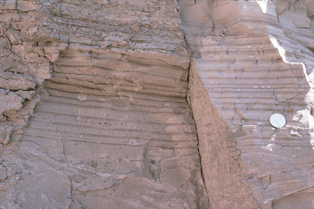rhythmite on:
[Wikipedia]
[Google]
[Amazon]
 A rhythmite consists of layers of
A rhythmite consists of layers of
 Rhythmites may be deposited with periodicities other than annual. The geologic record captures both more frequent events (e.g., tides) and less frequent events (glacial floods).
Rhythmites may be deposited with periodicities other than annual. The geologic record captures both more frequent events (e.g., tides) and less frequent events (glacial floods).
 A rhythmite consists of layers of
A rhythmite consists of layers of sediment
Sediment is a solid material that is transported to a new location where it is deposited. It occurs naturally and, through the processes of weathering and erosion, is broken down and subsequently sediment transport, transported by the action of ...
or sedimentary rock
Sedimentary rocks are types of rock (geology), rock formed by the cementation (geology), cementation of sediments—i.e. particles made of minerals (geological detritus) or organic matter (biological detritus)—that have been accumulated or de ...
which are laid down with an obvious periodicity and regularity. They may be created by annual processes such as seasonally varying deposits reflecting variations in the runoff cycle, by shorter term processes such as tides, or by longer term processes such as periodic floods.
Rhythmites serve a significant role in unraveling prehistoric events, providing insights into sea level change, glaciation change, and Earth's orbital variations which serve to answer questions about climate change
Present-day climate change includes both global warming—the ongoing increase in Global surface temperature, global average temperature—and its wider effects on Earth's climate system. Climate variability and change, Climate change in ...
.
Annually-laminated rhythmites
Annually-laminated deposits ( varves) are rhythmites with annual periodicity: annual layers ofsediment
Sediment is a solid material that is transported to a new location where it is deposited. It occurs naturally and, through the processes of weathering and erosion, is broken down and subsequently sediment transport, transported by the action of ...
or sedimentary rock
Sedimentary rocks are types of rock (geology), rock formed by the cementation (geology), cementation of sediments—i.e. particles made of minerals (geological detritus) or organic matter (biological detritus)—that have been accumulated or de ...
are laid down through seasonal variations that result from precipitation, or from temperature, which influences precipitation rates and debris loads in runoff. Of the many rhythmites found in the geological record, varves are among the most important and illuminating to studies of past climate change. Varves are amongst the finest resolution events easily recognised in stratigraphy
Stratigraphy is a branch of geology concerned with the study of rock layers (strata) and layering (stratification). It is primarily used in the study of sedimentary and layered volcanic rocks.
Stratigraphy has three related subfields: lithost ...
.
Periodically laminated rhythmites
Tidal rhythmites
Geologic tidal rhythmites display layered Carboniferous Period beds which record tidal cyclical events such as semi-diurnal, diurnal or neap tide,spring tide
Tides are the rise and fall of sea levels caused by the combined effects of the gravitational forces exerted by the Moon (and to a much lesser extent, the Sun) and are also caused by the Earth and Moon orbiting one another.
Tide tables ...
cycle that demonstrate marine influence in sediments that were previously interpreted as purely continental. The geologic record captures layered beds comparable to those found currently in sediments in the Bay of Fundy
The Bay of Fundy () is a bay between the Canadian provinces of New Brunswick and Nova Scotia, with a small portion touching the U.S. state of Maine. It is an arm of the Gulf of Maine. Its tidal range is the highest in the world.
The bay was ...
in Canada and the Bay of Mont Saint-Michel in France.
The Storm Mountain area of Big Cottonwood Canyon, Utah, has rhythmites which record sea-level sedimentary deposit fluctuations consistent with the cycle of the tides. Tidal rhythmites are also known from other geological periods and times, such as the late Precambrian
The Precambrian ( ; or pre-Cambrian, sometimes abbreviated pC, or Cryptozoic) is the earliest part of Earth's history, set before the current Phanerozoic Eon. The Precambrian is so named because it preceded the Cambrian, the first period of t ...
.
Proglacial rhythmites
One common mechanism is the episodic flooding which results from glacial dam bursts. In one such example geologists estimate that the Missoula Floods cycle of flooding and reformation of the lake took an average of 55 years and that the floods occurred approximately 40 times over the 2,000-year period between 15,000 and 13,000 years ago. Distinct rhythmites with an approximately 55-year periodicity have been observed.Glacial epicycle rhythmites
Sea-level changes which correspond to the glacial periods also show up as extremely long-term rhythmites. As an example, the ice surge in the Quaternary resulted in changes in sea level of 127 meters to 163 meters. The regression and transgression of the sea level from waxing and waning glaciers have been identified in the rhythmites of the Pennsylvanian and Permian periods.See also
*Dendrochronology
Dendrochronology (or tree-ring dating) is the scientific method of chronological dating, dating tree rings (also called growth rings) to the exact year they were formed in a tree. As well as dating them, this can give data for dendroclimatology, ...
* Dendroclimatology
* Touchet Formation
References
{{reflist Incremental dating Sedimentary rocks Sedimentology